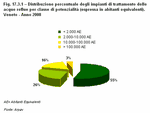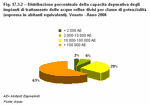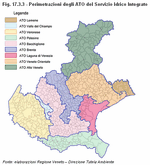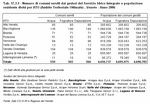(Note 1) Overall, the supply of water in the Veneto region is efficient: the water is safe, monitoring is carried out on a regular basis and the analyses required by law guarantee high-quality potable water.
Nonetheless, the network needs to be expanded to reach those areas that are currently supplied via private autonomous suppliers and to improve the overall system considering the increasing urbanisation in the region. Given the fact that the network is often quite old and characterised by significant leaks, special maintenance and the replacement of water pipes are often required. Furthermore, in addition to guaranteeing the potential of the network and qualitative safety, which are both fully guaranteed, the delivery capacity has to adapt to the demand coming from users. Some sources need to be strengthened and improved by building new wells and water treatment plants, especially in the cases in which current samples do not guarantee adequate delivery or high-quality water due to pollution in certain areas. These phenomena are primarily caused by industrial or agricultural activities that have led to a significant deterioration in the quality of the water table, the source of potable water, and contributed to a reduction in the groundwater table in recent years. Overall, it can be said that the water distribution network needs to be updated and interconnections between different municipalities need to be created in order to create a network of plants that extract and provide potable water. This way, the network will be able to guarantee efficiency and safety even when there are accidents, breakdowns or limited availability in specific areas where the water is drawn from.
In order to coordinate the initiatives of the Water Authority, Regione Veneto passed the Structural Model for Aqueducts (Modello Strutturale degli Acquedotti)
(Note 2), which develops the overall plan for the aqueducts in the region in addition to the sources of potable water to be protected. The end aim is to guarantee that residents have full and secure access to potable water by getting rid of the situations that lead to an excessive fragmentation of the aqueducts, which means integrating small- and medium-sized aqueducts that can produce significant economies of scale and resources; aims also include improving functionality. Another fundamental objective is to connect the existing large- and medium-sized water companies by developing large inter-provincial conduits. The aim is to create a system of aqueducts that is networked and can provide a more reliable service to users. Furthermore, by developing a network, the current supply and losses can be reduced in order to guarantee saving up to 15% of the potable water resources currently used. This new system will also guarantee the supply of high-quality potable water to areas in the region that are currently disadvantaged, i.e. the Bassa Padovana and the Polesine, where the water supply comes from the rivers Adige and Po which are noteworthy for the qualitative and quantitative problems related to the sources of the water.
The Structural Model identifies three significant water sources that are interconnected within the region: the "Central Veneto Aqueduct" (SAVEC), the "Garda Aqueduct" and the "Piedmont Aqueduct".
The Central Veneto Aqueduct is the largest one in the region and covers a broad area in the provinces of Venezia, Padova, Rovigo and Vicenza, providing water to about 600,000 residents and 400,000 non-residents. The water supply comes from, among other sources, the rivers Po and Adige, with high purifying costs and relatively low-quality water.
Through SAVEC, the needs of the Polesine area will be met mainly by rationalising the water drawn from the water table between the rivers Brenta and Sile and partially by increasing the amount of water drawn and by developing new sources.
As far as purification is concerned, following regional planning and the resulting plans made by the operators, the Authorities governing the Ambiti Territoriali Ottimali (ATOs), areas covered by integrated public services, have decided to centralise sewage treatment. In addition to creating economies of scale, this will make it possible to guarantee high-quality purification, optimised management of untreated sewage and continuous checking and monitoring of the quality of the sludge accumulated during the treatment process. Over time, water treatment plants have increased their purification capacity, i.e. the population equivalent (PE) or unit per capita loading, and improved sludge refinement.
By now, almost all of the major plants in Veneto carry out tertiary filtration and disinfection treatment and guarantee, in specific plant sections, nutrient removal (nitrogen and phosphorus), in order to protect the so-called "sensitive areas" (indicated in the Water Protection Plan) from the risk of eutrophication.
In the region, as of 2008, there are 521 registered water treatment plants that carry out secondary treatment (excluding the types of plants that carry out solely a physical sedimentation process).
There are 240 plants with a capacity greater than 2,000 PE
(Note 3). Of these, 138 are under 10,000 PE, 85 between 10,000 and 100,000 PE and 17 greater than 100,000 PE
(Figure 17.3.1) and
(Figure 17.3.2).
There are only 17 high capacity plants (more than 100,000 PE) (3% of the total), but these provide more than 60% of the total treatment capacity in the region.
As far as the integrated water service is concerned, the so-called Legge Galli (Law no. 36 dated 5 January 1994) was the first to provide systematic regulation for the sector, organising it around ATOs, which are established by the region with the agreement of the provinces. Regional Law LR no. 5 dated 27 March 1998, in response to the above-mentioned Legge Galli, established provisions regarding water resources and set up the ATOs. Article 2 indicates the division of regional territory into eight ATOs: Alto Veneto, Bacchiglione, Brenta, Laguna di Venezia, Polesine, valle del Chiampo, Veneto orientale, and Veronese. In addition, it also created ATO Lemene, an inter-regional ATO with Friuli Venezia Giulia, which includes some municipalities in the province of Pordenone (Friuli Venezia Giulia) and eleven municipalities located in the river basin of the rivers Livenza and Tagliamento (Veneto).
The aim of the ATOs is to guarantee an efficient network of aqueducts throughout the entire territory by developing initiatives and interventions that promote the development of a network of sewer systems and waste water treatment with the aim of improving the efficiency and effectiveness of operating costs, respecting environmental protection laws and safeguarding the use of water resources, especially with regards to potable water
(Figure 17.3.3) and
(Table 17.3.1).








